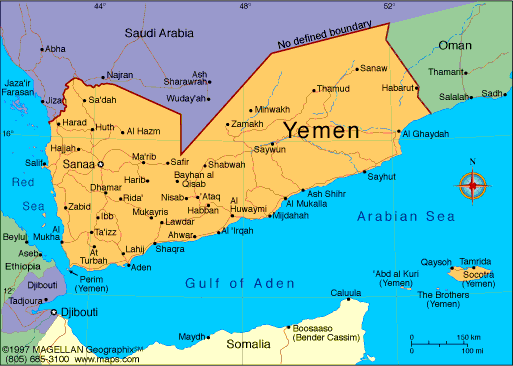Yemen Map: Regions, Geography, Facts & Figures | Infoplease
Yemen, officially known as the Republic of Yemen, is a country located in the Middle East on the Arabian Peninsula, also known as Western Asia. It shares borders with Saudi Arabia to the north, Oman to the east, and the Red Sea to the west. Yemen is strategically positioned at the southern tip of the Arabian Peninsula, overlooking the Gulf of Aden and the Arabian Sea. With the capital city of Sana'a and the country’s rich history and diverse culture, Yemen holds a significant place in the region.
If you want to discover more in-depth information on Iran as a country, check out our Republic of Yemen Profile!
Plus, test your country knowledge with our geography quiz, How Well Do You Know The World's Deserts?

History of Yemen
Yemen has a long and complex history, dating back to ancient times. It has been influenced by various civilizations, including the Sabaean and Himyarite kingdoms. The city of Sana'a, the capital of Yemen, holds a special place in history due to its architectural beauty and heritage.
Over the centuries, Yemen has witnessed political changes and conflicts, including the rise and fall of different dynasties. In recent years, Yemen has faced challenges, including the ongoing civil war. Other causes of conflict include involvement by other Middle Eastern countries, such as Iran, the United Arab Emirates, Kuwait, Qatar, Syria, Iraq, Jordan, and others.
Arab Influence in Yemen
Yemen has a deep-rooted connection to the Arab world, as it is located in the heart of the Arab Peninsula. The Yemeni people have embraced the Arabic language, culture, and traditions, making Yemen an integral part of the Arab world.
The Houthi Rebellion in Yemen
The Houthi rebellion, also known as the Houthi insurgency, was a significant political and military conflict in Yemen. The rebellion originated in the northern part of the country and was led by the Houthi movement, which was officially known as Ansar Allah, leading to changes on the political map. However, the conflict has de-escalated since ceasefires in 2022.
Geography of Yemen
Yemen is characterized by diverse geography. It is known for its mountainous landscapes, particularly in the western part of the country. The coastal plain along the Red Sea and the Arabian Sea offers stunning views and access to the coastline. Yemen is home to several governorates, each with its own unique features and attractions. The country's geography also includes significant landmarks such as the Wadi Hadhramaut and the archipelago of Socotra.
Yemen also shares maritime borders with several countries, including Djibouti, in the Horn of Africa, Somalia, and Eritrea along the Red Sea.
The Bab-el-Mandeb Strait
The Bab-el-Mandeb Strait is a narrow passage connecting the Red Sea and the Gulf of Aden. It is of great strategic significance, as it is a major shipping route for international trade. The Bab-el-Mandeb Strait is an important maritime chokepoint, with Yemen's coastline being a crucial point of control.
Tourist Attractions in Yemen
The map of Yemen boasts numerous tourist attractions that showcase its rich cultural heritage and natural beauty. Some of the most prominent cities, such as the Shabwah, Ibb, and Al Hudaydah, offer historical sites, ancient architecture, and bustling markets. The ancient city of Marib is known for its ancient dam and archaeological ruins. The coastal city of Mukalla is popular for its stunning beaches and vibrant fishing industry. Additionally, the historic city of Dhamar and the port city of Aden are worth exploring.
Major Cities in Yemen
Yemen is home to several major cities, each with its own unique characteristics and attractions. Here are some of the notable cities in Yemen:
-
Sana'a: Sana'a is the capital and largest city of Yemen. It is known for its stunning architecture, including the iconic Old City, which is a UNESCO World Heritage site. Sana'a offers a glimpse into Yemen's rich history and cultural heritage.
-
Aden: Aden is a historic port city located in southern Yemen. It has a strategic location along the Gulf of Aden and has been an important trading hub for centuries. Aden is known for its beautiful beaches, vibrant markets, and historical landmarks.
-
Ta'izz: Ta'izz is a city in southwestern Yemen. It is known for its beautiful landscapes, including the impressive Ta'izz Mountains. The city is also home to historical sites such as the Al-Qahira Castle and the Islamic Great Mosque of Ta'izz.
-
Al Hudaydah: Al Hudaydah, also known as Hodeidah, is a coastal city on the Red Sea. It is Yemen's fourth-largest city and has a bustling port. Al Hudaydah offers beautiful beaches and is a gateway to the stunning island of Socotra.
-
Ibb: Ibb is a city located in the western part of Yemen. It is known for its picturesque landscapes, including terraced fields and lush greenery. The city also has historical sites, such as the Al-Qasimi Mosque and the Ibb National Museum.

People Also Ask...
If you're inspecting the Yemen map, you may have some queries about the region. Here are some of the most frequently asked questions, along with their answers.
What Is the Largest City in Yemen?
The largest city in Yemen is Sana'a, which also serves as the capital.
What Is the Political Situation in Yemen?
Yemen has been facing a complex political situation, with various conflicts and a civil war.
Where Is Yemen Located on the World Map?
Yemen is located in Western Asia, on the southern tip of the Arabian Peninsula, bordered by Saudi Arabia, Oman, and the Red Sea.
|
|








